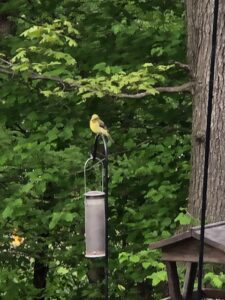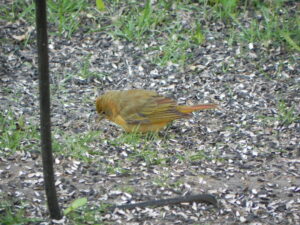by Winding Pathways | Jun 25, 2020 | Birds, Garden/Yard, Nature
She feeds ’em. I shoot ’em.
Guest Bloggers STB
Yes, this sounds like a love/hate relationship. But, it is truly pure enjoyment for my wife and me to witness the birds that visit our backyard feeder here in SE Minnesota.
Throughout the year a variety of birds comes from the woods to feast at my wife’s feeder. From late April to early May the orioles make their appearance. Baltimore Orioles have a vivid bright orange color and the Orchard Oriole has a noticeably darker burnt orange color. The recent reality of retirement has allowed us more time for photography and our birds have become a passion.
Capturing a static image of a perched bird is relatively easy but my goal has been to catch them in their interactions and flight. Shutter speeds of 1/1000th of a second or faster are recommended and patience is mandatory but the results might get you hooked. Beware…
-
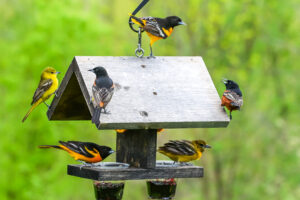
-
The jelly attracts the orioles.
-
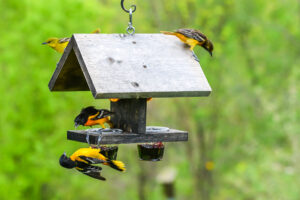
-
Sparring over rights to the jelly.
-
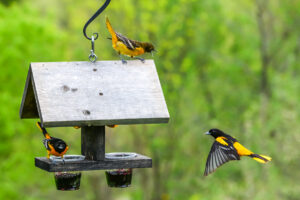
-
Warding off the in-coming oriole.
by Winding Pathways | Jun 18, 2020 | Birds, Garden/Yard, Nature
Another beautiful, blue-sky day. This early morning I am drinking tea and looking out the patio windows. As I enjoy the view of the freshly cut lawn and watch the birds flit about, a bit of busy-ness above the deck catches my attention. A small, loose clump of grey moss trembles and jerks around. It seems suspended like a little tube sock from a maple branch.
A tiny head and two bright eyes appear. In a wink, she’s gone. Moments later, another flash, this time with a hint of yellow. More trembling and jerking around, on the branch. And now I’m sure we have a nesting pair in our tree at the end of the deck.
Despite the yellow, her beak is too long and slender to be a goldfinch. A burst of warbling and I think it might be ‘Mistress Mary’, one of my favourite songbirds that keeps me company on long summer afternoons.
I can look forward to hours of entertainment.
Mistress Mary is just my name for a songbird whose phrases sound like an event organizer ordering people around:
“Jay-jay, sorry, Jo-Jo, sit here.”
“That’s your story?
“So?”
“Bring it here.”
“Will you do it?”
“Where are you?”
“Do ya think?”
She has quite a repertoire of a dozen or so phrases that she repeats faithfully. Fun to listen to. I first heard her about five years ago.
The Hermit thrush has also arrived in Eastern Canada for his summer stay. His ethereal song echoes in the woods.
Readers, scroll through the article in the New York Times to read an interesting article interspersed with bird sounds: Hear 13 Birds Flourishing in a Newly Quiet New York (City).
by Winding Pathways | Jun 11, 2020 | Birds, Garden/Yard, Nature
We’re lucky. Scarlet tanagers nest near us. Winding Pathways abuts Faulkes Heritage Woods, a protected 110-acre forest of mostly monstrous oak trees. So, every May we’re delighted as this brilliant bird arrives and sets up home.
Male scarlet tanagers appear at our feeders in mid-May. Females come a few days later. The male’s amazingly brilliant red feathers and contrasting black wings make the bird unmistakable. For only a week or two they visit the orange-colored suet we set out and pick sunflower seeds from silo feeders. Then they disappear. We knew they abandoned our yard to nest near the tops of big oaks in the nearby woods, but they are very hard to spot there, even as they sally forth to catch insects from mid-air catching a meal. Their summer diet is mostly insects.
-
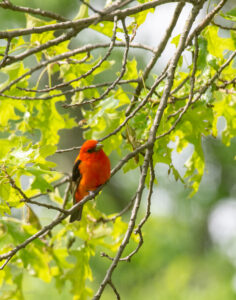
-
The male scarlet tanager arrives. several days ahead of the female.
-
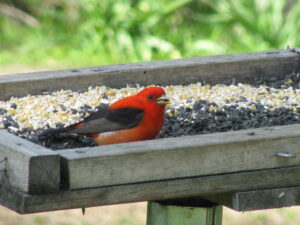
-
The tanagers willinging come to the platform feeder.
We wondered where they went after nesting and consulted our friend Jim Berry, retired executive director of the Roger Tory Peterson Institute in Jamestown, New York. Here’s what he wrote:
“Once the baby birds fledge, familial responsibilities end and the birds move away from forests to places where they can find food and molt. Often these are old fields and marshes, where they seem to disappear. This is called the post-season dispersal.
They soon replace their brilliant red feathers with duller-colored new ones that help them migrate.”
Jim told us we are lucky to have scarlet tanagers come to our feeders. They don’t where he lives in Western New York.
After they molt the birds fly all the way to northwestern South America for the winter. We won’t see them again until next May.
These are breathtakingly beautiful birds that brighten our yard for just a short while each year. We’re humbled to be able to host them.
by Winding Pathways | May 28, 2020 | (Sub)Urban Homesteading, Amphibians/Reptiles, Garden/Yard
For many years Rich wrote a nature column for the Cedar Rapids GAZETTE about little known aspects of natural history common in suburbia. He was amazed when more people responded to a column on toads than anything else he had written. People like toads. Some readers called him to talk about “their” toad that lives in the garden or a damp corner in the garage. They wondered what treats they could give “their” toad.
Toads Range Far and Wide
Toads herald spring’s arrival with lusty evening trilling, usually in May. Common and intriguing, they enjoy living in suburban yards as well as woodlands and wetlands.
Many toad species inhabit the world but the Eastern Toad is most common in the United States. It ranges from about Nebraska east to the Atlantic and from southern states north to nearly Hudson’s Bay in Canada.
Where do Toads Live?
Both toads and frogs are amphibians. (The bloopers at the end of this video are fun to watch! Shows what it takes to put together even one short educational video!)
Toads, however, spend much of their lives away from water. A damp shady place to live and plenty of insects and other invertebrates to eat suits their needs. Toads often spend the day hiding in damp garages, under rotting logs, and in secluded garden spots. Come evening they hop around seeking tasty bug meals.
As amphibians toads need standing water to reproduce. Each spring toads hop to ponds, wet road ditches, and big puddles to serenade the night with their loud trilling. Females lay two strings of eggs in the water that hatch into tadpoles within two weeks. The warmer the weather the faster the eggs hatch. Toad tadpoles are easy to recognize. They are tiny, black, and have bodies much larger than their thin tail. Often hundreds swarm in a small pool. In less than two months they change into mini toads that hop far and wide seeking a place to live. They’ll eventually grow to about three inches long.
-
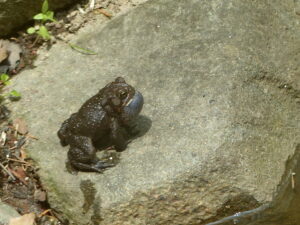
-
Toads sing loudly day and night.
-
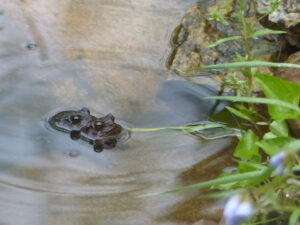
-
Toads need water to mate.
Who Eats Toads?
Although many animals enjoy a frog meal, few eat toads. When bothered toads often emit a foul-tasting liquid that makes a hungry dog or raccoon immediately drop the animal unhurt. Probably their main predator is the hognose snake, which relishes a toad meal.
Caring for “Your” Toad
Most people like toads and many gardeners create damp quiet places in their gardens for them to take shelter during the day and forage for pesky insects come nightfall. As for a toad treat, well, they really don’t need one but they might like to snack on a few mealworms or earthworms.
#
by Winding Pathways | May 21, 2020 | (Sub)Urban Homesteading, Garden/Yard
Planting Day
Saturday, May 9th was our big day. We planted our newest prairie and we’ll tell you how after we explain the ground preparation we did before a single seed was dropped to the ground.
We’ve established several prairies with no ground preparation by simply broadcasting seed on an existing lawn and waiting……a long time. For the first two years, there was little evidence of prairie, but we let the lawn grass grow tall and burned it each fall. By the third year, prairie plants started to appear. We continued annual burns and by the fourth and fifth year, it had more prairie than lawn plants, and every year it got better.
Shortcut Method
For our new prairie, we wanted to shortcut the process and get it established much faster. We knew that involved spraying the lawn with herbicide to kill the grass plants and weeds. Following spraying we’d till the area, smooth it out, and broadcast our prairie seeds. We had a problem. We lacked sprayers and machines, so months ago we hired Sustainable Landscape Solutions to spray and till.
On a Monday in late April, they arrived and sprayed the area we had marked off. It’s about 3000 square feet. The old turf began showing stress in a few days, but the sprayers had missed a few spots. They returned a week later and sprayed it again. On Friday, May 8 they arrived with a mini skid loader and rotadairon attachment. This amazing machine tilled up the now dead grass and left the area with a mild textured pattern that looked perfect for seeding.
-
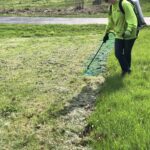
-
Caitlin carefully applies spray.
-
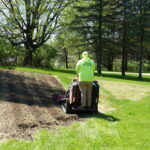
-
The rotadairon machine quickly turns over the dirt.
Other Cooperators
We had bought a Leopold 2 seed mix from Pheasants Forever weeks ago and had it in storage. It contained a blend of at least 70 native wildflowers and some short profile grasses. We didn’t want tall big bluestem, switchgrass, or Indian Grass and asked that they be excluded from the mix. Allendan Seed Company removed the tall-growing seeds and added in some Little Bluestem, Sideoats Grama, and Prairie Dropseed. Our prairie will be mostly flowers with some grasses that don’t get tall. Prairie restorationists and botanists often call wildflowers forbs. It’s a useful word to know.
We had a problem. We’d bought enough seeds to cover a half-acre, but we were seeding only 3000 square feet, so we had about seven times too many seeds. Still, they only weighed 3.36 pounds and were all in a rather small bag. We decided to plant heavily and put them all on the new prairie.
Mixing Steps
Many prairie plant seeds are so tiny they’re hard to see. Some are fluffy and blow in the breeze. A technique helped us get an even planting. We dumped two gallons of fine sand into our wheelbarrow and poured in just enough water to make it damp…….not wet. Then while one of us mixed the sand with a shovel the other dribbled the prairie seeds on the sand and soon we had a sand/seed mix. We mixed about half the seeds, or three pounds, into about 30 pounds of sand.
The sand does at least three important things. First, it adds bulk to the seeding mix, making broadcasting easier. Second, tiny seeds cling to the moistened sand grains weighing them down. That way the sand and clinging seeds don’t blow in the wind and descend to the ground where we want them. Third, the sand we used was blond and it contrasted with the black dirt in the planting area. It helped us spot areas we had planted and get uniform coverage.
We put the sand and seed mix in small buckets and walked side by side gently broadcasting seed as we walked along. We paced ourselves so we covered the entire area about when half the seed/sand mix was exhausted. Then we mixed the rest of the seed with damp sand. We filled our buckets and walked across the area at right angles to our first seeding, broadcasting seed as we walked along. Soon the entire area was seeded as evenly as we could possibly do it.
After a short coffee break, we took leaf rakes and very lightly raked the area, pulling a thin layer of dirt over the seeds and ensuring good seed/soil contact. We were done.
-
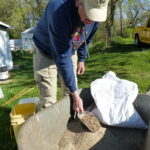
-
Rich mixes the seeds and sand with water.
-
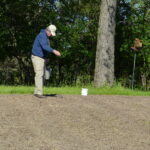
-
Rich broadcasts the sand-seed mixture on the newly tilled ground.
-
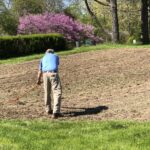
-
Gently rake the seeds in.
Other Considerations
Again, there are many ways to seed a prairie. Several commercially made seed drills work great and are most appropriate for big areas. And, many people have created small prairies by avoiding seeding completely and buying plugs of prairie plants from nurseries. Two good sources are Prairie Moon Nursery (www.prairiemoon.com) and Ion Exchange (www.ionxchange.com). Using plugs is expensive but works well for tiny prairies or when introducing new plants into an established prairie. Skipping the herbicide and tilling also works but takes several more years to establish the planting and some prairie plants may not be able to compete with existing lawn grass.
Now the Hard Part
Now, all we had to do was wait for gentle rain and warm weather to kindle germination.
Our next installment of blogs on our prairie restoration project will be about tools we use and the management of the newly seeded area. Tune in soon.
by Winding Pathways | May 15, 2020 | (Sub)Urban Homesteading, Flowers/Grasses, Garden/Yard, Garden/Yard
Moving Forward
Once we made the decision to convert about 3,000 square feet of our lawn to a prairie, we began active planning. We have 40 years of prairie establishment and management experience so it was easy for us, but we still needed help and sought partners.
We contacted many organizations and found support for our project from these people and groups:
Sustainable Landscape Solutions, a business based in Iowa City. We hired them to do ground preparation. Sean Pearl is the owner.
Monarch Research Project, an active Cedar Rapids-based group that encourages pollinator plantings.
Linn County Secondary Roads. Since our prairie is near a Linn County road we wanted their support.
Pheasants Forever. We received help from a biologist, Allie Rath, and bought an outstanding seed mix from Pheasants Forever. Matt O’Connor manages the seed store and encouraged us to buy a Leopold Mix that contains about 72 species of flowers. Our seeds were produced at the Allendan Seed Company in southern Iowa.
Good Neighbor Iowa. This organization encourages people to shun lawn chemicals and plant native vegetation. A key contact is Audrey Tranlam.
Requirements
We wanted the prairie to be diverse in plant species, establish as rapidly as possible, and be “short profile”. Meaning we did not plant tall big bluestem, Indian grass, and Switchgrass.
We chose the Leopold mix because it has a diversity of flowering plants. And, Pheasants Forever kindly removed the tall-growing grasses from the mix for us.
Preparing and Seeding
Years ago when we began restoring prairies at Indian Creek Nature Center, it was impossible to buy seed, and little was known about how to establish a healthy native grassland. The Center had no money to invest in planting. Jock Ingels was a savvy restorationist based in Illinois. He gave us this advice, “If you don’t have any money but want a prairie, go pick some seeds and broadcast them into the existing lawn. Then burn it. Then wait. You’ll think you wasted your time because nothing will show after a year or even two years but burn it annually. By the third year, you’ll see prairie plants appear and it will get better each year after.” He was right. We gathered seed, planted at the Indian Creek Nature Center, and burned it annually.
At the Nature Center, we got a prairie at no cost and avoided herbicides and ground preparation but it had a limited diversity of species. The newly established prairie was far healthier ecologically than the bromegrass that was once there. For the prairie we wanted to establish at our home, we wanted a more diverse prairie and more quickly. So, we chose a faster method. Mind you, we are not keen on sprays but recognize they have a place.
Sustainable Landscape Staff sprayed our lawn with roundup in late April to kill the grass. They returned one week later and resprayed it to kill the remaining grass.
-

-
Caitlin carefully applies spray.
-
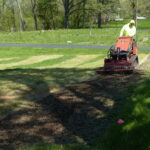
-
Tilling up the lawn.
-
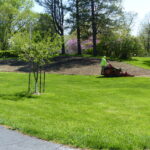
-
Finishing the edge.
-
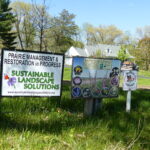
-
Three cooperators’ signs.
They returned a week later and rototilled the area to expose the soil. Spraying and tilling allows newly planted native seeds to grow with less competition from exotic lawn species. It emerges as a more diverse prairie faster than if spraying and tilling are avoided.
In the next installment of this series, we’ll show photos of us seeding the prairie and explain various other ways of establishing a prairie or pollinator meadow. But because lawns are now growing and people are mowing we’ll leave with this thought:
There’s a no-cost method of diversifying a lawn that reduces work. Simply mark off a section of the lawn and don’t mow it. It can be small. Many native plants have durable seeds that remain dormant in the soil for years or decades. They can’t succeed with constant mowing, so to increase plant diversity simply stop mowing a section of lawn and try to identify the new plants that emerge. You will help pollinators.
There’s a new phone app that we’re using to help identify plants we’re not familiar with. It’s called SEEK and is produced by the National Geographic Society, the California Academy of Science, and other groups. It’s free and can be accessed from the app store. You point the phone at a plant, insect, bird, or even a fungus, click a photo, and SEEK will identify it for you. It’s mostly accurate.






